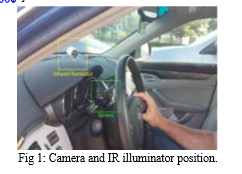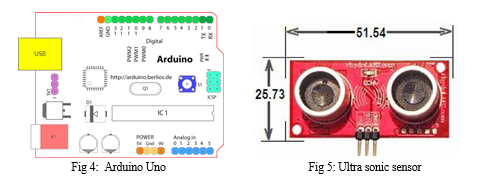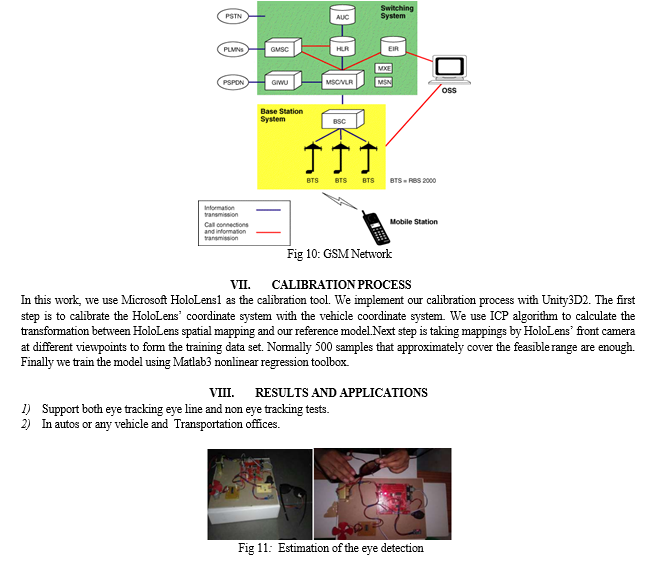Ijraset Journal For Research in Applied Science and Engineering Technology
- Home / Ijraset
- On This Page
- Abstract
- Introduction
- Conclusion
- References
- Copyright
Real Time Driver Gaze Tracking and Eyes off the Road Detection System
Authors: Pallam Venkatapathi, Kondu Vinay, Kummathi Harshavardhan Reddy, Mulli Karthik, Dr. Sudhakar Alluri
DOI Link: https://doi.org/10.22214/ijraset.2023.56316
Certificate: View Certificate
Abstract
Driver Gaze Tracking and Eyes Off the Road Detection System is a technology-driven solution designed to enhance road safety by monitoring driver behavior and detecting instances when the driver\'s attention is diverted from the road. The system utilizes computer vision techniques and machine learning algorithms to track the driver\'s eye movements and identify potential distractions. By providing real-time alerts and warnings, this system aims to mitigate the risk of accidents caused by distracted driving. Distracted driving poses a significant risk to road safety, and traditional methods have limitations in ensuring immediate compliance. By leveraging computer vision and machine learning, the system provides a proactive approach to detect distractions and alert drivers, ultimately reducing the occurrence of accidents caused by diverted attention. In conclusion, the Driver Gaze Tracking and Eyes Off the Road Detection System offers a technological solution to enhance road safety by monitoring driver behavior and detecting distractions. By promptly alerting drivers when their attention is diverted, this system contributes to mitigating the risks associated with distracted driving and promoting safer road environments.
Introduction
I. INTRODUCTION
Driver Gaze Tracking and Eyes Off the Road Detection System is to improve road safety by monitoring driver behavior and detecting instances when the driver's gaze is diverted from the road. The specific objectives of the system include: Gaze Tracking: Develop a robust and accurate gaze tracking mechanism that can effectively monitor the driver's eye movements and determine their gaze direction in real-time. Distraction Detection: Utilize machine learning algorithms to analyze the driver's eye movements and identify instances when their gaze is off the road for an extended period or engaged in distracting activities. Real-Time Alerts: Implement a mechanism to provide immediate alerts and warnings to the driver when distractions are detected, aiming to redirect their attention back to the road and prevent potential accidents[1-3].
II. LITERATURE REVIEW
Driver Distraction and Inattention Monitoring and Warning System: A Review. IEEE Transactions on Intelligent Transportation Systems, 20(9), 3268-3280. Cho, S., Lee, H., & Baek, S. (2018).
The Driver Gaze Tracking and Eyes Off the Road Detection System is an innovative approach designed to enhance road safety by monitoring driver behavior and detecting instances when the driver's attention is diverted from the road. This system leverages advanced technologies such as computer vision and machine learning algorithms to track the driver's eye movements and accurately determine their gaze direction. By continuously monitoring the driver's gaze, the system can identify potential distractions, including looking at mobile devices or engaging in activities that take their eyes off the road
Chen, T., & Chuang, C. (2019). Driver Distraction and Inattention Monitoring and Warning System: A Review. IEEE Transactions on Intelligent Transportation Systems, 20(9), 3268-3280.
The Driver Gaze Tracking and Eyes Off the Road Detection System insures Messaging, perusing, and dialing cause the longest time of drivers taking their Eyes off the Road (EOR) and increment the danger of slamming by three overlap. A late review demonstrates that these hazardous practices are across the board among drivers, 54% of engine vehicle drivers in the United States ordinarily have a mobile phone in their vehicles or carry PDAs when they drive. Checking driver exercises shapes the premise of a security framework that can conceivably decrease the quantity of accidents by distinguishing peculiar circumstances. Creators demonstrated that an effective vision-based distracted driving recognition framework is based upon solid EOR estimation, see Fig. 1. Be that as it may, constructing ongoing EOR location framework for genuine driving situations is extremely trying for a few reasons: (1) The framework must work amid the day and night and under genuine enlightenment conditions; (2) Changes in drivers' mind posture and eye developments changes in drivers' mind stance and eye developments result in extreme changes in the facial elements (e.g., student and eye corners) to be followed. By accurately monitoring driver gaze, detecting distractions, and providing real-time alerts, this system contributes to promoting safer driving practices, reducing accidents, and creating a more secure road environment for all road users
A Real-Time Driver's Eye Gaze Tracking Algorithm for Drowsiness Detection System. Sensors, 18(11), 3907. Alhassan, H., Ahn, S., & Baik, S. (2018). Driver's Gaze Tracking Techniques for Vehicle Control Systems.
User-Friendly Interface: Design a user-friendly interface for the system that provides clear and intuitive alerts to the driver without causing additional distractions or cognitive load. Scalability and Reliability: Develop a scalable and reliable system architecture that can handle real-time processing of eye-tracking data, accommodate multiple drivers simultaneously, and operate effectively in various driving conditions. The ultimate objective of the Driver Gaze Tracking and Eyes Off the Road Detection System is to reduce the occurrence of accidents caused by distracted driving. By monitoring driver behavior, detecting distractions, and providing timely alerts, the system aims to promote safer driving practices and enhance overall road safety.
Visual Distraction Detection in Vehicle Driving: A Systematic Review. IEEE Transactions on Intelligent Transportation Systems, 21(9), 3692-3704. Xiong, Z., & Chen (2018)
Distracted driving detection and prevention systems have gained significant attention in recent years. Several existing systems and technologies are designed to address the issue of distracted driving and enhance road safety. Some of the notable existing systems include: Mobile Device Management Systems: These systems utilize software applications or hardware devices that restrict or block the use of mobile devices while driving.
III. EXISTING SYSTEM
Driver observing has been a long standing exploration issue in PC vision. It is past the extent of the paper to audit every single existing framework; however we give a portrayal of the most applicable work in the scholarly world and industry. For a total diagram of existing frameworks. Extensively, there are two ways to deal with gauge look bearing[4]: Techniques that exclusive utilize the head posture and those that utilization the driver's head stance and look. Driver checking has been a long standing examination issue in PC vision. From the video stream of a camera introduced on the controlling wheel segment, our framework tracks facial elements from the driver's face[5].

IV. PROPOSED SYSTEM
At the point when a driver's look is not situated inside the essential consideration zone (which Covers the focal part of the frontal windshield) for a predefined period, an alert is Activated. By the by, no further insights about the execution of the framework in genuine Driving situations were accounted for. The framework forever screens the development of the driver's head when looking from side to side utilizing a close IR camera introduced on the highest point of the controlling wheel segment[6]. To cross the street programmed speed controller. The framework is coordinated into Toyota's pre-crash framework, which cautions the driver when an impact is plausible. Another business framework is Face LAB, a stereo-based eye tracker that identifies eye development, head position and turn[7]. The proposed framework does not require any driver-subordinate alignment or manual introduction and works continuously, amid the day and night. ADVANTAGES Distracted driving is one of the primary driver of vehicle impacts in the United States. Latently checking a driver's exercises constitutes the premise of a car wellbeing framework that can possibly decrease the quantity of mishaps by assessing the driver's concentration of consideration[8]. This paper proposes a reasonable vision-based framework to precisely identify Eyes off the Road (EOR).
The framework has three primary parts:
- Robust facial element following;
- Head stance and gaze estimation; and
- 3-D geometric thinking to distinguish EOR. From the video stream of a camera introduced on the guiding wheel segment, our framework tracks facial components from the driver's face[9-10].
V. SYSTEM REPRESENTATION

- Arduino Uno (ATMEGA328): Controller is heart of our system. This controller following features: 32Kbytes of in-system programmable flash with read-while-write capabilities, two 8-bit Timer/Counters, 23 programmable I/O Lines, and operating Voltage is 1.8 - 5.5V, Temperature Range -40°C to 105°C, three flexible Timer/Counters.Pin configuration of ATmega328 IC consists of 28 pins. There is Port B, Port C & Port D an 8-bit bi-directional I/O port with internal pull-up resistors[12].
- Ultra Sonic Sensor: This "ECHO" Ultrasonic Distance Sensor from Rhydolabz is an amazing product that provides very short (2CM) to long-range (4M) detection and ranging. The sensor provides precise, stable non- contact distance measurements from 2cm to 4 meters with very high accuracy. Its compact size, higher range and easy usability make it a handy sensor for distance measurement and mapping. The board can easily be interfaced to microcontrollers where the triggering and measurement can be done using one I/O pin. The sensor transmits an ultrasonic wave and produces an output pulse that corresponds to the time required for the burst echo to return to the sensor. By measuring the echo pulse width, the distance to target can easily be calculated[13-14].

VI. EYE BLINK SENSOR
A. General Description
The eye is illuminated by an IR led, which is powered by the +5v power supply and the reflected light is recorded by an IR photo diode. This eye blink sensor is IR based; the variation across the eye will vary as per eye blink. The exact functionality depends greatly on the positioning and aiming of the emitter and detector with respect to the eye. If the eye is closed means the output is high otherwise output is low[15].
B. Product Description
Connect regulated DC power supply of 5 Volts. Black wire is Ground, Next middle wire is Brown which is output and Red wire is positive supply. These wires are also marked on PCB. To test sensor you only need power the sensor by connect two wires +5V and GND. You can leave the output wire as it is. When Eye closed, LED is off & the output is at 0V.Put Eye blink sensor glass on the face within 15mm distance, and you can view the LED blinking on each Eye blink. The output is active high for Eye close and can be given directly to microcontroller for interfacing applications[16].
C. Features
- EYE BLINK indication by LED..
- Instant output digital signal for directly connecting to microcontroller.
In common parlance a Buzzer is a signaling device that is not a loudspeaker. It can be mechanical, electromechanical, or electronic (a piezo transducer). BeStar produces Buzzers in every available configuration for a wide variety of applications[17]. A Piezo transducer can produce the sound for panel mount buzzers, household goods, medical devices and even very loud sirens. When a lower frequency is required an electromagnetic buzzer can fill the need. These are very common in automotive chimes and higher end clinical diagnostic devices. The BeStar buzzer range includes self drive units with their own drive circuitry (indicators), or external drive units, which allow the designer the flexibility to create their own sound patterns[18].

GSM (Global System for Mobile communications) is a cellular network, which means that mobile phones connect to it by searching for cells in the immediate vicinity. GSM networks operate in four different frequency ranges. Most GSM networks operate in the 900 MHz or 1800 MHz bands. Some countries in the Americas use the 850 MHz and 1900 MHz bands because the 900 and 1800 MHz frequency bands were already allocated. The rarer 400 and 450 MHz frequency bands are assigned in some countries, where these frequencies were previously used for first-generation systems[19].
GSM-900 uses 890–915 MHz to send information from the mobile station to the base station (uplink) and 935–960 MHz for the other direction (downlink), providing 124 RF channels (channel numbers 1 to 124) spaced at 200 kHz. Duplex spacing of 45 MHz is used. In some countries the GSM-900 band has been extended to cover a larger frequency range. This 'extended GSM', E-GSM, uses 880–915 MHz (uplink) and 925–960 MHz (downlink), adding 50 channels (channel numbers 975 to 1023 and 0) to the original GSM-900 band[20]. Time division multiplexing is used to allow eight full-rate or sixteen half-rate speech channels per radio frequency channel. There are eight radio timeslots (giving eight burst periods) grouped into what is called a TDMA frame. Half rate channels use alternate frames in the same timeslot. The channel data rate is 270.833 kbit/s, and the frame duration is 4.615 ms.

Conclusion
In conclusion, the Driver Gaze Tracking and Eyes Off the Road Detection System represents a significant step forward in addressing the issue of distracted driving. By accurately monitoring driver gaze, detecting distractions, and providing real-time alerts, this system contributes to promoting safer driving practices, reducing accidents, and creating a more secure road environment for all road users.
References
[1] Driver Distraction and Inattention Monitoring and Warning System: A Review. IEEE Transactions on Intelligent Transportation Systems, 20(9), 3268-3280. Cho, S., Lee, H., & Baek, S. (2018). [2] Chen, T., & Chuang, C. (2019). Driver Distraction and Inattention Monitoring and Warning System: A Review. IEEE Transactions on Intelligent Transportation Systems, 20(9), 3268-3280. [3] A Real-Time Driver\'s Eye Gaze Tracking Algorithm for Drowsiness Detection System. Sensors, 18(11), 3907. Alhassan, H., Ahn, S., & Baik, S. (2018). Driver\'s Gaze Tracking Techniques for Vehicle Control Systems. [4] Visual Distraction Detection in Vehicle Driving: A Systematic Review. IEEE Transactions on Intelligent Transportation Systems, 21(9), 3692-3704. Xiong, Z., & Chen (2018) [5] Venkatapathi Pallam, Vasudev Biyyala, Chandra Shekar Jadapally, Ramsai Nalla, Dr. Sudhakar Alluri, Doctors Assistive System Using Augmented Reality Glass Critical Analysis, Ijraset Journal For Research in Applied Science and Engineering Technology, ISSN : 2321-9653, Oct 2023. [6] Qiang Ji, Xiaojie Yang, Real-Time Eye, Gaze, and Face Pose Tracking for Monitoring Driver Vigilance, Real-Time Imaging,Volume 8, Issue 5,2002 [7] S.J. Lee et al. Real-time gaze estimator based on driver’s head orientation for the forward collision warning system IEEE Trans. Intell. Transp. Syst.(Mar. 2011) [8] F. Vicente et al.Driver gaze tracking and eyes off the road detection system IEEE Trans. Intell. Transp. Syst.(Mar. 2015) [9] Xu, X.; de Sa, V.R. Exploring multidimensional measurements for pain evaluation using facial action units. In Proceedings of the 2020 15th IEEE International Conference on Automatic Face and Gesture Recognition (FG 2020), Buenos Aires, Argentina, 16–20 November 2020; IEEE: Piscataway, NJ, USA, 2020; pp. 786–792. [10] An, Z.; Zhou, A.;Hei, X.; Gao,Y.;Zhang,C. Towards Automatic Engagement Recognition of Autistic Children in a Machine Learning Approach. In Proceedings of the 2019 IEEE International Conference on Engineering, Technology and Education (TALE), Yogyakarta, Indonesia, 10–13 December 2019; pp. 1–8. [11] Badgujar, P.; Selmokar, P. Driver gaze tracking and eyes off the road detection. Mater. Today Proc. 2022, 72, 1863–1868. [12] Geisinger, B.N.; Raman, D.R. Why they leave: Understanding student attrition from engineering majors. Int. J. Eng. Educ. 2013, 29, 914. [13] M.Santosh , Venkatapathi Pallam, Vehicle Position of Self-Recognition using Ultra High Frequency Passive RFID Tags. International Journal of Scientific Engineering and Technology Research, Volume 3, Issue 32,2014, Pages 6294-6300 [14] Patrick, A.D.; Prybutok, A. Predicting persistence in engineering through an engineering identity scale. Int. J. Eng. Educ. 2018, 34, 351–363. [15] Good, C.; Rattan, A.; Dweck, C.S. Why do women opt out? Sense of belonging and women’s representation in mathematics. J. Personal. Soc. Psychol. 2012, 102, 700. [16] Whitcomb, K.M.; Singh, C. Underrepresented minority students receive lower grades and have higher rates of attrition across STEM disciplines: A sign of inequity? Int. J. Sci. Educ. 2021, 43, 1054–1089. [17] Hieb, J.L.; Lyle, K.B.; Ralston, P.A.; Chariker, J. Predicting performance in a first engineering calculus course: Implications for interventions. Int. J. Math. Educ. Sci. Technol. 2015, 46, 40–55. [18] Bego, C.R.; Barrow, I.Y.; Ralston, P.A. Identifying bottlenecks in undergraduate engineering mathematics: Calculus I through differential equations. In Proceedings of the ASEE Annual Conference & Exposition, Columbus, OH, USA, 25–28 June 2017. [19] Kajander, A.; Lovric, M. Transition from secondary to tertiary mathematics: McMaster University experience. Int. J. Math. Educ. Sci. Technol. 2005, 36, 149–160. [20] Bellinger, D.B.; DeCaro, M.S.; Ralston, P.A. Mindfulness, anxiety, and high-stakes mathematics performance in the laboratory and classroom. Conscious. Cogn. 2015, 37, 123–132. [21] Fredricks, J.A.; Blumenfeld, P.C.; Paris, A.H. School engagement: Potential of the concept, state of the evidence. Rev. Educ. Res. 2004, 74, 59–109.
Copyright
Copyright © 2023 Pallam Venkatapathi, Kondu Vinay, Kummathi Harshavardhan Reddy, Mulli Karthik, Dr. Sudhakar Alluri. This is an open access article distributed under the Creative Commons Attribution License, which permits unrestricted use, distribution, and reproduction in any medium, provided the original work is properly cited.

Download Paper
Paper Id : IJRASET56316
Publish Date : 2023-10-26
ISSN : 2321-9653
Publisher Name : IJRASET
DOI Link : Click Here
 Submit Paper Online
Submit Paper Online

